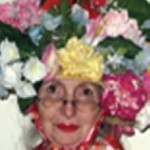Hey, Miss Floribunda,
I’m not the kind of dude who has ever been into gardening. I mow the lawn and clip the hedges on my property to keep from being fined. That’s been it until now. Since your hat always gets my attention when I look at the HL&T, I know about you and that you write about gardening stuff. I think you can handle my question.
Yesterday I got lost up around Derwood and came across a lot filled with flowers that looked like they came from outer space. For real. I had to get out of the car and look closely. I can’t begin to tell you all the weird shapes. Some had only a few petals, others were packed with them. Some looked so artificial, like those fold-out Halloween pumpkins made out of paper, that I had to look at the ground to make sure they weren’t just stuck in on sticks. The colors were intense! They were in every combination — stripes, circles, spots, dribbles. They made me think of pinatas. Some were almost as big as pinatas, though these looked like frisbees or exploding fireworks. Others were almost as small as popcorn.
So what were they? How do you grow them? I’ll do whatever it takes.
Pumped up on Powhatan Street
Dear Pumped Up,
You came across the exhibition garden of the National Capital Dahlia Society. There are more than 50,000 varieties of this amazing plant. You will be glad to know that they are easy to grow if you don’t mind digging them up after the first frost and storing them inside till spring. To start, you buy the tubers in the spring from any nursery, hardware store or online, plant them in pots or directly in the soil after the soil is warm, and forget about them. They are rarely bothered by pests or disease. Most like full sun, although some prefer partial shade. They are drought-resistant. They multiply, which can present a problem with time unless you want to be like Johnny Appleseed and distribute them wherever you can. More about that later. Let’s get to their colorful history.
The dahlia comes from Mexico and is that country’s national flower. Dahlia tubers, which are edible, were grown for food by the Aztecs in Mexico in pre-Columbian days. The flowers were very simple, in only four colors: white, red and yellow and “blackish.” A very tall variety with hollow stems was used for water pipes. By the time Cortez arrived in the 16th century, Montezuma had non-utilitarian ornamental ones growing in his garden at Hauxtepec. However, it wasn’t until 1789 that Vicente de Cervantes, director of the Mexican Botanical Gardens, sent seed of the edible variety to the Abbe Cavanilles at the Madrid Botanic Garden in the hope that it would rival the potato as a staple food. Cavanilles planted, illustrated and named it. He called it them Dahlias in honor of a distinguished Swedish botanist, Andreas Dahl, who had died in May 1789. I had always assumed Professor Dahl had developed various varieties of the flower, but as Al Acocotli — the dahlia expert who set me straight — acerbically pointed out, “The deceased rarely participate in scientific experiments other than seances.”
After their arrival in Spain, seeds were sent to other European countries, and in 1804 Alexander von Humbolt sent ornamental double-flowered dahlia seeds from Mexico to Paris and Berlin. By the 1830’s, competitions were awarding prizes for new varieties. The dahlia had become a prestige flower craved by the rich the way the tulip had been in the 17th century. In time it has become affordable to all.
Here’s a sampling of the basic varieties: the cactus dahlia, which has pinnate petals like those of the flowers of real cacti; star dahlias with sunburst shape; waterlily dahlias that open with layers of broad flat petals; the elaborate peony dahlia; the smaller chrysanthemum dahlia; the anemone dahlia with thick petals like those of sea anemones; the collerette dahlia, which has what looks like a lacy collar of smaller petals in contrasting colors; the formal decorative dahlia, which is honey-combed so that it looks like those Halloween fold-out pumpkins you mention, the ball and pompon dahlias, whose names speak for themselves. The range of colors and color patterns is beyond my ability to describe and as you noticed the contrasts in size are prodigious. The largest are called “dinner-plate” dahlias and really do look like fireworks.
Now I am going to compare dahlias to Amish friendship bread. Years ago I was given the starter of Amish friendship bread and it soon became a real nuisance. After the recipient bakes bread using some of the starter, a bit of the starter mix has to be passed on to someone else. I eventually ran out of friends to give bread and starter to (possibly because I feared burdening others with this obligation) and threw away my remaining starter mix. When I first came to Hyattsville I was delighted when Mr. Acocotl shared dahlia tubers with me. They were easy to grow and the results were spectacular. However, I soon ran out of people to whom to give the tubers I’d dug up in the fall and would try to press them on perfect strangers. Then, I gave up and began to leave them in the ground. Winters were mild and they returned in the summer for several years. But when the Year Of Snowmageddon hit I lost them all. Your enthusiasm tempts me to give them another chance.
The Hyattsville Horticultural Society will not meet in August, but the August Miss Floribunda will let our readers know about our plans in September.









